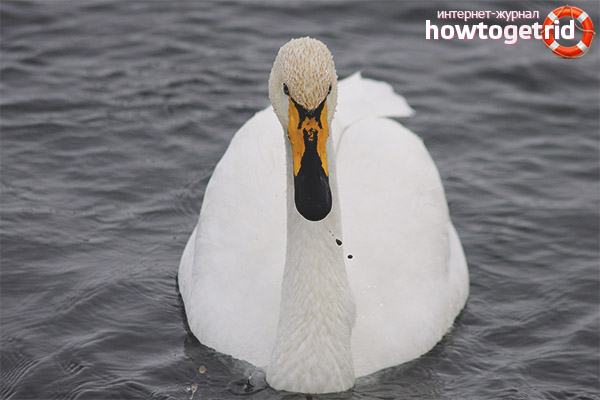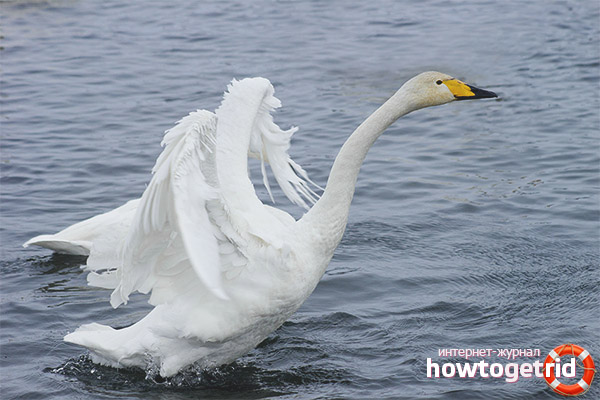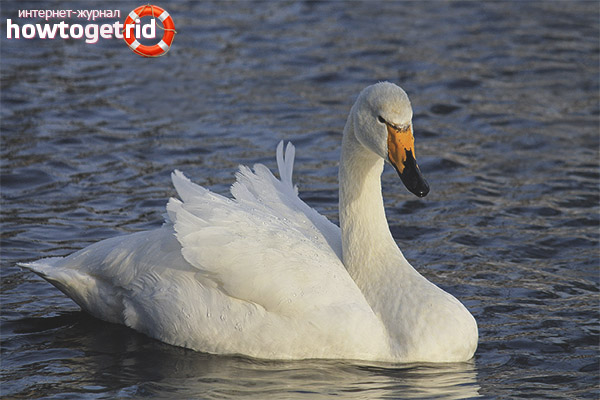The content of the article
Swans occupy a leading position among the most beautiful birds in the world. They are a symbol of fidelity, prosperity and wealth. People decorate with statuettes of swans wedding celebrations. They believe that this bird will make the marriage of the newlyweds strong. Whooper is considered an ardent variety of swans. The bird belongs to the order of goose and the family of ducks. Beautiful, stately, deserving the most detailed study. This is what we will do today.
Description
Experts have come to the conclusion that whoopers are rightfully considered the largest individuals of their kind. These swans are famous for their impressive dimensions; an individual can weigh 8-15 kg. The case is larger than 1.5 meters. Agree, impressively. This subspecies can be identified by a graceful elongated neck, as well as snow-white plumage and short strong paws. Birds have a beak of a black-yellow hue along the length of 9-12 cm.
It is interesting that these swans acquire their snow-whiteness only after puberty and several molts. As a rule, this happens when the bird reaches the age of 3 years. Until three years pass, the birds remain light gray in shade. With all this, the head is usually darker than the rest of the body.
It may seem to an inexperienced eye that the birds are in no hurry, moving slowly, and turning badly. But we really are not. They are proudly swimming and can at any moment begin to move at an incredible speed. When the swan wants to take off, he goes over the surface of the water with his paws and pushes off. Then he hovers in the air, proudly dodging danger. Due to the fact that these individuals are large-sized, they do not like to move on land and do so with reluctance.
Habitat
The presented variety is migratory. When the cold cycle begins, individuals prefer to relax on the shores of the Mediterranean Sea, the Caspian Sea or Asia. Therefore, they easily gather in a flock and leave the expanses until next year.
However, not every bird can go for winter to warmer climes. If they live already in warm regions, they don’t need to fly away somewhere. They will either shift to the southern parts, or they will remain and will survive to heat.
Lifestyle
Birds almost never visit land; most of their lives are spent in water sources. This aspect is due to the short legs and dimensions of the swans.
It is difficult for them to move on dry terrain, so in such conditions the birds feel uncomfortable. They prefer to go out only forcedly and return to their usual aquatic environment as quickly as possible.
As for water, this breed feels great in such conditions. Birds seem unhurried, but this is a misleading impression. As soon as the danger is brewing, the swan quickly picks its paws on the water and takes off.
Nutrition
- In most cases, the considered individuals prefer the nutrition of plant foods. Mostly swans feed on aquatic plants, their roots and shoots. In addition, birds can often feast on small fish, larvae and invertebrate inhabitants.
- Young individuals often get their food off the coast. Chicks dive in search of live food.It is worth noting that adults need a lot of protein food. It is for this reason that adult swans are increasingly refusing plant foods.
- Such individuals prefer not to feast on plants, but on small fish, larvae and invertebrates. It is worth knowing that the considered individuals almost always remain in the same place. They are not one of those individuals who leave their habitat.
- Even if there are problems with food, the swans will still remain and will look for a way out of the situation. It is not uncommon that, due to lack of food, the birds are completely exhausted. They don’t even have the opportunity to ascend to heaven. However, such individuals recover very quickly.
Life expectancy and reproduction
- The considered individuals live on average about 10 years. Swans reach puberty only at the age of three. In addition, at this time, the color of the plumage noticeably changes in individuals. It takes on a snow-white appearance instead of gray.
- As for the mating season, in the represented individuals it occurs approximately with the end of winter. The male attracts the attention of the female, emitting a trumpet loud scream. In addition, he begins to perform a marriage dance in front of his beloved.
- The male’s voice makes quite interesting sounds. Such birds hiss in rage or at the moment of irritation. At this time, such sounds are like a goose hiss. After the pair is formed, they begin to build a nest.
Interesting Facts
- Represented individuals are considered one of the largest birds that live in Russia.
- Whoopers belong to the only species of swans that have a straight neck. They simply do not have a bend.
- Adults are so strong that a wingspan can break a person’s arm or kill a small animal.
- During the division of the territory or during the mating season for the attention of the female, the males arrange pretty fierce fights.
- At all times, such birds have attracted people's attention. Because of this, many incredible legends appeared. People considered swans a symbol of fidelity and love.
Birds of this group often settle in open water sources, where there is a decent amount of thickets near the coastline. Whoopers also live in the seas and lakes. It is extremely rare to settle near a person’s houses, but this is regarded by people as a sign from above.
Video: Whooper Swan (Cygnus cygnus)












Submit